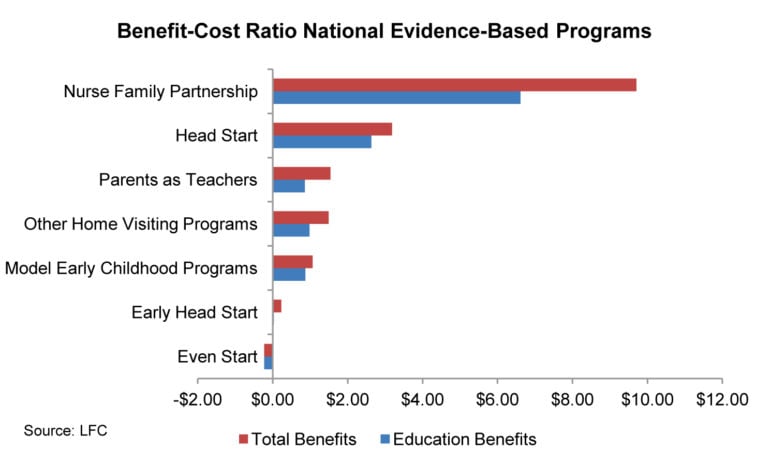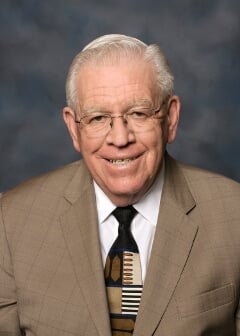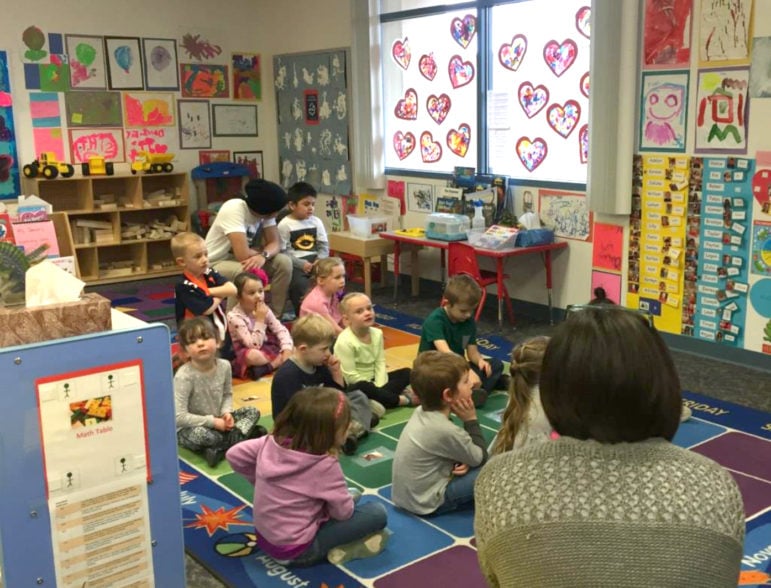
New Mexico Public Education Department
Young children listen to a teacher as part of the summer K-3 Plus program.
How New Mexico educates its children will be in the hands of a state judge soon as a landmark trial against the state Public Education Department wraps up.
Over eight weeks, the trial has featured dozens of witnesses and numerous citations to academic studies and policy reports. But in the end, the trial before First Judicial District Judge Sarah Singleton in Santa Fe boiled down to dueling worldviews.
The plaintiffs — the New Mexico Center on Law and Poverty and the Mexican American Legal Defense and Educational Fund (MALDEF) — cited education outcomes for low-income, Native American and English language learners as evidence that New Mexico does not meet its constitutional obligation to provide a sufficient education for all children.
And they recommend a wholesale transformation of the education system to target at-risk students earlier and with greater resources to help close the education achievement gap.
“It was very clear from the defense that the state is in denial about the educational crisis that New Mexico students face,” said Marisa Bono, MALDEF Southwest regional counsel. “We look forward to a ruling from the Court that will force the state to stop fiddling while Rome burns, and start providing equal educational opportunities to all students.”
State education officials, the defendants in the case, however, said that while it is unfortunate that not all New Mexico students read at high levels or are adept at math, it doesn’t violate the constitution.
They cautioned that money alone can’t guarantee better outcomes and emphasized the importance of raising expectations and holding schools districts and teachers accountable in how they manage reforms at the classroom level. Those reforms, set in place under former Public Education Department Secretary Hanna Skandera, are showing signs of improvement, they said.
The Martinez administration did not respond to a request for comment, but acting PED Secretary Christopher Ruszkowski testified during the trial and characterized the view that poverty drives poor educational outcomes for certain students — an argument made by the plaintiffs — as “the soft bigotry of low expectations.”
Skandera herself seemed to advocate taking a race/ethnicity-blind approach to education during a September 2016 deposition, a portion of which was entered as evidence in the lawsuit.
“I would say when it comes to supporting our students when they’re struggling, we’re not looking at the color of their skin, we’re looking at how do we support them in their unique needs,” she said in the deposition.
A ruling in the case is expected this fall or winter.
However Singleton decides the case, her ruling faces the prospect of an appeal by the losing side. Still, her ruling whether or not the state has violated its constitutional mandate to provide “free public schools sufficient for the education of … children” could help set the foundation for how New Mexico educates future generations of children.
Dismal data
The end of court testimony Friday is the latest phase in the 2014 lawsuit the plaintiffs filed against a backdrop of the perennial drumbeat of bad educational news.
New Mexico’s education statistics are familiar and persistent: 49th or 50th in the nation in educational outcomes since 2012, according to the Annie E. Casey Foundation; only a quarter of third-graders proficient in reading and math on the 2015 PARCC test; 43 percent of New Mexico college students needing remedial classes in 2015, according to the Public Education Department.
The Center on Law and Poverty and MALDEF lawsuit hammered on those statistics during the trial to prove the state woefully underfunds education to the tune of as much as $600 million.
Additional money would enable the state to expand to all school districts programs shown to improve educational outcomes for low-income students, among other things, they said.
One example advocates highlighted is the K-3 Plus program, which adds 25 days to the school year for low-income students in Kindergarten through third grade.
A Utah State University study found that Kindergarteners in the extended school year were more prepared for school and outperformed their peers, and that the effects continued four years later, though the differences waned for those heading into third grade.
As effective as it is, K-3 Plus is in only around 50 of New Mexico’s 89 school districts and while nearly 70,000 students attend program-eligible schools around the state, only a fifth of those students will receive instruction this summer. There are 15,000 slots available, down from nearly 19,000 last summer, according to a legislative report.
“It’s simply underfunded. There are not enough slots,” said Edward Tabet-Cubero, executive director of the Center on Law and Poverty.

Credit/New Mexico Legislative Education Study Committee
K-3 Plus has been a victim of its own success. More school districts want to incorporate it into their instructional efforts and state education officials have green-lighted new programs. At the same time, a bad economy has constrained funding. In simple terms, the state is spreading the same amount of dollars across a bigger area.
For example, in Rio Rancho, that school district’s 2017 program shrank by 100 slots, Superintendent Sue Cleveland testified from the stand last month, according to the Albuquerque Journal. At the same time new K-3 Plus programs were authorized this summer for Mesa Vista Consolidated Schools, Zuni Public Schools, and Taos International Charter School, the legislative report said.
In Santa Fe, across town from where the eight-week trial took place, Aurora Gonzalez and her family were reaping the benefits of the K-3 Plus program.
Her stepson, a rising third-grader, is enrolled at Ramirez Thomas Elementary School. Gonzalez has noticed a change in his behavior, she said.
Last year, when she and Noah’s father worked with him, sometimes for hours a day, Noah struggled, Gonzalez said through an interpreter.
This summer, teachers are tutoring him and kindling his interest in math and other subjects. “Now he is coming home and doing his math independently,” Gonzalez said.
“It was a good decision” to enroll him.
“Helping them as a parent with their school is the only thing you can give them as inheritance,” she said.
Similar to K-3 Plus, studies have shown that children enrolled in other early childhood education programs such as Pre-Kindergarten and home visiting programs show higher rates of proficiency in reading and math, are held back less often, and are less likely to need special education. The results are often greater for low-income children.
But as with the K-3 Plus program not all children who are eligible for the program have access to it.

Consistently rising dollars
In recent years, school spending has risen for pre-Kindergarten and K-3 Plus despite trying economic times. From 2012 to 2015, funding for pre-K rose from $17 million to $36.6 million and about $6 million to $21.6 million for K-3 Plus, according to a state Legislative Finance Committee report.

Credit/New Mexico Legislative Education Study Committee
State Sen. John Arthur Smith, chairman of the Senate Finance Committee, which helps write the state budget, questioned whether some districts are spending dollars efficiently and wonders if state money could be used more wisely by consolidating small, rural districts and through better monitoring of how school districts spend their money.

Sen. John Arthur Smith, D-Deming
He also pointed to other states in the Southwest that are spending less per student but getting better results.
Utah is one of the best-run school systems in the West, he said, but spends $6,500 per student, the lowest per student spending in the United States. That compares to $9,752 New Mexico spent per student in 2014-15, according to the U.S. Census.
However, the percent of children living in poverty in Utah is less than half that of New Mexico, which has the second-highest number of children living in poverty, at 29 percent, according to the Annie E. Casey Foundation 2017 Kids Count report.
And, just 5.9 percent of Utah students are English language learners. In New Mexico that number is 16.1 percent, according to the website Education Commission of the States.
“I’ll concede some of those might not have the diversity of population of ethnic groups,” Smith said. “But even within this state, one of the highest at-risk schools, we have pretty high performance. Gadsden (Independent School District) was sort of an example of that.”
Investments not enough to scale up
Advocacy groups and some legislators say New Mexico has made some improvements, but it’s not enough to make a difference when you consider the vastness of the problem.
And while it is true that education funding from the state has risen in recent years, it is still below the pre-2007 recession levels and is 14 percent lower than the national average, according to a new report from the Census Bureau. New Mexico’s per-student funding, at $9,752 in 2014-15, was 34th in the nation.

Sen. Bill Soules, D-Las Cruces
State Sen. Bill Soules, D-Las Cruces, who is a former school teacher, noted that school spending has dropped from half of the total budget to “about 42-43 percent.”
“We have consistently tried to do education on the cheap,” Soules said.
Also ripe for review, advocates said, is how the state parcels out its education dollars to schools.
At one point, New Mexico’s funding formula was one of the most progressive in the nation — in the late 1960s and early ’70s, Tabet-Cubero said. The state moved from funding through local property taxes to paying for schools at the state level. The State Equalization Guarantee, a per-student funding formula, helped to even out vast disparities between districts in richer and poorer areas of New Mexico.
But now, it’s time to look at that formula again, he said.
“Districts with low-income children only get about a 3 percent bump in their per-student funding … that’s definitely not enough,” he said. And, even with targeted funding for at-risk students, the “entire formula, the entire SEG is grossly insufficient.”
Soules said bringing the state’s commitment back up to that 50 percent mark would allow the state to offer universal access to early childhood education for 4-year-olds, would fully fund K-3 Plus, and could be used to dramatically boost pay for school teachers, instructional aides and early childhood educators — addressing a chronic shortage of teachers in the state, attracting the best and the brightest to the front of the classroom, and making access to high-quality day care more available.
Smith countered that the 50 percent commitment reflects a time when the state’s population and government were far smaller. The current 42 to 44 percent range is more sustainable.
Finding the money
Some legislators say the money is there to improve New Mexico schools despite a sluggish economy, depressed oil prices and persistent budget shortfalls in recent years. What is lacking, they said, is political will.

Sen. Mimi Stewart. D-Albuquerque
“It’s not like we don’t know where there are funds that we ought to be able to use,” said Sen. Mimi Stewart, another former educator and chair of the Legislative Education Study Committee.
Extra funding for schools could come from raising the rate on what top earners pay in state personal income tax, which was lowered by Gov. Bill Richardson and the Legislature in 2003, Stewart and Soules said. Reversing changes made to the corporate income tax rate by Martinez and the Legislature in 2013 could help, too. Tapping the Land Grant Permanent Fund, a fund generated by the state’s natural resources and used to support schools, and overhauling the state’s gross receipts tax also could yield more education dollars, they said.
The Richardson tax cut was estimated as a $325 million hit to the treasury, according to a fiscal impact report at the time, and while the corporate income tax is one of the most volatile taxes in the state, the Legislative Finance Committee estimated a $70.7 million reduction to the general fund for 2017. A proposal to take an extra 1 percent from the Permanent Fund would be estimated to bring in about $150 million more that could be used for schools and early childhood education. Smith said the GRT exemptions for food and medicine cost the state about $400 million a year.
But persuading Gov. Susana Martinez, a second-term Republican governor, to sign a tax hike would be unlikely.
“We have a governor who regardless of reason or purpose doesn’t want to raise taxes, even if it’s the repeal of a tax cut that probably never should have happened,” Soules said in reference to the 2003 personal income tax cut.
What comes next
Even if the plaintiffs prevail in court, any turnaround in education will be years, perhaps even decades in the making, advocates acknowledged.
The state PED under Martinez is likely to appeal the ruling if it loses, as would the advocacy groups if Singleton sides with the PED. The trial’s results are likely just the end of the beginning of the court battle. Other states that have been sued over education funding have remained in the courts for decades.
And even if the PED doesn’t appeal, there is a chance the Legislature will fight encroachment on its power over the purse strings.
“The judge could say, next year you’ve got to put $600 million into education, I don’t care how you do it,” says Soules. “That would spark some real interesting constitutional questions because there will be push back from legislators that would say our responsibility is appropriating money, not the judiciary. And that would probably end back up in court.”
That’s a scenario the Center on Law and Poverty plans to fight back on aggressively.
“We’ll continue to use a court decree to bring the state back to court to hold them accountable for their responsibility,” Tabet-Cubero said. “I think ourselves and other advocates are committed to holding the state accountable to whatever the outcome is of this case.”
Another factor is that Martinez only has a year and a half left on her final term in office.
“We have people running for governor. They’re all gonna be talking about how to change education,” said Stewart. “I think when we get a new administration, we can make the changes that we need to do.”
Smith, for one, doesn’t believe the judge will order a particular dollar amount. But with the lawsuit seeking $350 to $600 million, he doesn’t see where that’s going to come out of a state government that has been shrinking during the entirety of Susana Martinez’s terms in office.
According to Smith, higher education has lost about 3,300 employees over three or four years, there is a vacancy rate of more than 40 percent for correctional officers, a 30 percent vacancy in judicial clerks, a 12-14 percent vacancy at the Motor Vehicles Division.
“Everyone says look over here for money, we can look over there, but that’s not enough to wad a shotgun as far as making the fix in the event we lose that case,” he said.
Trip Jennings contributed to this report.

Photo from the K3 Plus Program annual report.
Did they study the effect of “public shaming” for unpaid lunches on children? did they enter the impact of bilingual students who are mastering two linguistic systems? Poverty does not equate low IQ but it does impact hunger, health, self-concept and other issues. How about the cultural and linguistic biases of these tests. Please address all issues, Ms. Skandera.